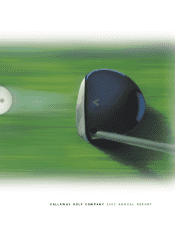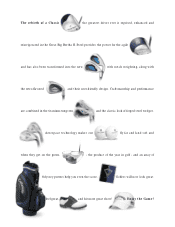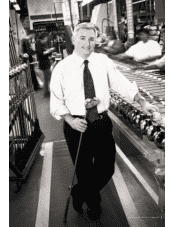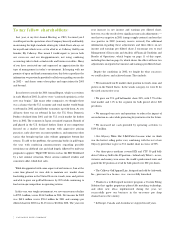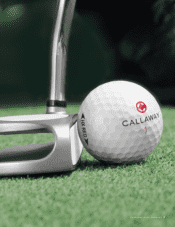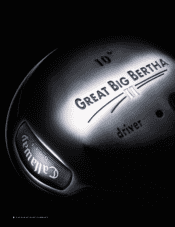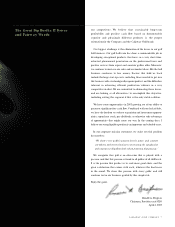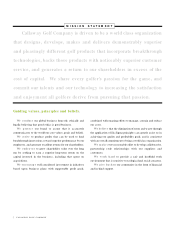Callaway 2002 Annual Report Download - page 6
Download and view the complete annual report
Please find page 6 of the 2002 Callaway annual report below. You can navigate through the pages in the report by either clicking on the pages listed below, or by using the keyword search tool below to find specific information within the annual report.
Along with these successes, there also were setbacks. Our
biggest disappointment came from sales of the C4 Compression
Cured Carbon Composite Driver. Although it generated revenues
which, standing alone, would exceed the total revenues of some of
our competitors, it did not achieve sales levels we have come to expect
from our premium products. Its performance characteristics are
undeniably exceptional, and many golfers absolutely love it, but the
lack of a powerful sound at impact seemed to limit its appeal to many
golfers. Our Store-in-Store fixturing program improved our brand
and product presentation at retail, but it does not appear to have
proportionately driven revenue growth. And even though our golf ball
sales improved, the business continued to generate losses that not only
are not acceptable, but that also have increased year over year.
We are reviewing both our successes and our failures, and we will
learn from both.
In keeping with our pledge and commitment to good corporate
governance, in 2002 our Board of Directors tasked its Executive
Committee to conduct a full “governance review.” This review
included all regulatory and legal requirements, as well as the
consideration of governance practices used by other leading
corporations or recommended by the NYSE, institutional investors,
educators or others knowledgeable in the field. A full report on this proj-
ect can be found on the corporate governance portion
of the Investor Relations section of the Company’s website at
www.callawaygolf.com. A few highlights include:
• The Company has updated and reaffirmed the Corporate Code
of Conduct and Ethics Policy it adopted in 1997.
• The Company’s Board of Directors, which has been composed
of a majority of independent directors for several years, adopted a
formal policy requiring that a “substantial majority” of the Directors be
independent. Through 2002 the Board was composed of five
independent directors and one management director, the CEO.
• The Board has also adopted a formal policy that the independent
directors shall meet formally in executive session on a regular basis
(e.g., at board meetings) without members of management. This
expands upon a practice where our directors have for a long time
conferred with each other informally in the absence of management
regarding Company matters, and the formal practices of the Audit
and Compensation and Management Succession Committees of
meeting in executive session, without management.
• Consistent with NYSE proposals, the Board of Directors has
selected a lead independent director to preside at the executive
sessions of the independent directors. The lead independent director
at this time is Ronald S. Beard.
• The Board of Directors has formed a separate Nominating and
Corporate Governance Committee composed solely of independent
directors.
• The Audit Committee of the Board of Directors has been and
is composed entirely of independent directors. Members of the Audit
Committee have satisfied NYSE rules requiring financial
literacy and/or accounting or related financial management expertise.
• The Compensation and Management Succession Committee
of the Board of Directors has been and is composed entirely of
independent directors.
•
Consistent with recent proposals, the Company has established
formal procedures for the certification of certain financial and other
disclosures, including filings with the SEC on Form 10-K and Form 10-Q.
Our commitment to good corporate governance and clear, mean-
ingful communications to our shareholders and investors is driven
more by our personal pledge than by laws and regulations. I think we
are recognized as one of the few companies that use “pro forma”
reporting sparingly, and only when it clarifies – rather than obscures
– understanding of our real operations. For example, in 2001
accounting rules required that we take a non-cash charge associated
with the unused portion of a long-term energy supply agreement,
and accounting rules have prevented us from reversing that charge
even though the agreement has been terminated. In 2002 we had a
non-cash positive adjustment because of a reversal in warranty
reserves. Because accounting rules require us to include these two
non-cash adjustments in net income and earnings per diluted share,
we reported in 2002 an improvement in net income and earnings
per diluted share. But we also told you throughout the year, as I did
at the beginning of this letter, that a true view of our operations
would exclude these one-time, non-cash adjustments. When you
exclude these items, we show a decline, not an improvement, in
these metrics. We gave you the facts even though they were not
required and they put our results in a more negative light, because
that is the right thing to do.
CALLAWAY GOLF COMPANY 3

